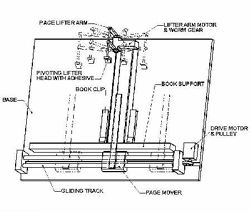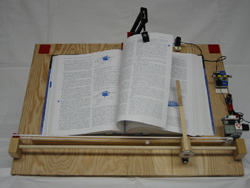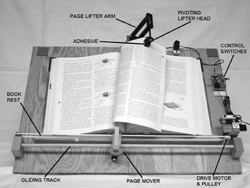A New Approach to Automated Page-Turner Design Implementing a Re-usable Adhesive
ABSTRACT
Reading is the simplest and greatest avenue for recreation and learning. Therefore, people with disabilities should not be restricted to the limited book titles that have been converted to books on tape or e-books. A new design for an automated page-turner has been developed which will be single switch activated, simple and reliable, reversible, lightweight, require no preparation of the book, easily loaded, utilize a reusable, washable adhesive and affordable. Although there are commercially available page-turners, the manual models require some type of user dexterity and lack functionality while the automated models, of which there are only two, are over-complex and consequently, heavy and non affordable. The proposed design represents a significant improvement over the exiting art and broadens that range of those who might benefit from such a device.
KEYWORDS
Page-turner, page, turner, book, assistive technology
BACKGROUND
The switch-activated automated page-turner is meant for readers who lack the dexterity to turn the pages of a hardcover book, the stamina and strength to maintain it in a tilted position, or those who need to flip pages and have only a single finger available for one instant. This non-comprehensive list includes individuals suffering from a physical disability, patients weakened by medical procedures, and the elderly.
Using only the disability criterion, According to the US Census Bureau Americans With Disabilities data Institute on Disability and Rehabilitation Research, approximately 6.8 million people fifteen and older in the U.S. have difficulties in grasping objects and 15.2 million people have difficulties in holding or lifting objects of 10 pounds or more [1].
STATEMENT OF PROBLEM
Although there are currently numerous sources of entertainment, including the television and computer, the quiet and simple pleasure of reading a good book is irreplaceable. Books can serve many purposes, from providing an escape from reality to satisfying one's thirst for knowledge. Disabled people should also be able to indulge in reading without being restricted to the limited titles available as e-books or on tape.
Many patients, caretakers and healthcare professionals acknowledge that there exists a need for an accessible page-turner that works and is affordable. This includes the In-patient Therapy Supervisor and the Medical Director of Rehabilitation from Kent County Memorial Hospital in Warwick , Rhode Island , who have expressed demand for a functioning page-turning device. In addition, Marybeth, an electric wheelchair bound Rhode Island resident with low upper body strength and poor motor control, claims that existing automated page-turners can be too complicated, too costly or simply do not work. She is an educational speech pathologist who has tried both manual and automated page-turners with no success.
Manual page-turners, which are relatively common, often involve a stick clipped to the user's hand or placed in their mouth. Their proper use requires an inordinate amount of dexterity. In contrast there exist only two products in the automatic page-turner market; both of which are extremely complex and priced between $2000 and $3000, outside the budget of most disabled people.
There are numerous U.S. page patents for devices to turn pages. However, it is obvious that many were never prototyped and most exhibit either over complexity, with regard to operation and number and nature of actuators, or are missing some crucial features.
APPROACH
This new page-turner design aims to fulfill this need by providing a device that is user-friendly, simple, single switch-activated, reversible, portable and cost-effective. The automated page-turner is intended to turn the pages of any size hardcover book in both directions. Hardcover books were selected since they are more common than softcover and their relatively solid structure facilitates securing. Most titles, be they recreational or textual, are available in such form – even softcover “dime novels” are usually found in hardcover at a local library. Designing to turn the pages of magazines, and especially newspapers, would result in an unnecessarily complex and less accessible device, since online subscriptions are becoming increasingly available. Additionally, current event information can easily be obtained via the Internet or television. In contrast, books as print media, even with the advent of e-books, have not seen a decrease in popularity or availability.
The simplicity of the mechanisms improves reliability and decreases device cost. Single switch activation means that a gentle touch upon one button will initiate a page turning cycle, which will be completed with no further input from the user. Pages may be turned from either left to right or right to left to allow a user to turn back in a book. A number of clamping mechanisms are undergoing testing and the final incarnation will be such that people with minimal dexterity will be able to load a book themselves. Lightness and portability, with the possibility of mounting on a wheelchair will increase user-friendliness. Paramount to commercial success is low cost since the majority of potential users are on fixed incomes.
METHOD
 |
|---|
The diagram of the switch-activated page-turner is shown in Figure 1. The device is comprised of two commercially available gear motors of which one activates the page-lifting arm while the other activates the timing belt controlled wiping arm. They can be powered by any 12 volt source, including an electric wheelchair's battery. The book is placed in a clamp with the spine aligned with the lifting arm's axis. The lifting arm and motor assembly moves up and down to accommodate books of different dimensions. A wiping arm, mounted on a track parallel to and below the book rest, serves to catch a lifted page and turn it to the opposite side of the book. A motorized timing belt controls its sideways motion. The base of the design is made of a lightweight plastic called Lexan â . The base has been placed on a durable, hinged arm that can be easily adjusted so that book is at a comfortable reading angle to the user. A wheelchair-mounting clamp is under consideration.
 |
|---|
Activation is accomplished by depressing a single switch that commences a microprocessor-controlled sequence. (1) The lifter arm rotates downwards in an arc, from its vertical rest position, towards the page, with the adhesive pad maintained parallel to the book by means of a swivel. (2) The lifter arm contacts the book and ceases to rotate, by means of a slip clutch. This occurs once sufficient force is applied in order to assure adhesion. (3) The lifter arm rotates upward along with the page. (4) The wiping arm then moves from left to right or right to left, catches the fold of the page, peels it off the swiveling adhesive pad and turns it. The swiveling adhesive design ensures proper pressure and adequate surface area and thus consistent adhesion. (5) When the wiping arm reaches the end of its track engaging a limit switch, the motor reverses and it is returned to its right-hand rest position. The cycle is complete.
 |
|---|
The Alpha prototype, which demonstrates the ability to lift a page, peel it off the adhesive and turn it in either direction with the wiping arm, is shown in Figures 2 and 3.
Along with the previously discussed improvements on the existing art much of the originality of the design is due to the implementation of a commercially available washable adhesive, which can, after many uses, be cleaned with water and re-used after it dries. This adhesive is strong in shear and weak in stress. As the lifter arm rotates in an arc towards the upward and the page is held in shear. Then when the wiping arm begins pulling on the adhesive pad rotates and the page peels easily off. Additionally, it must be emphasized that the operation will be book independent, i.e. no special sensors will be used to detect page position or book thickness.
Last year's RESNA winning page-turner has been viewed and the method of turning pages bears no resemblance to the design presented here [2].
DISCUSSION
Most existent designs succumb to over-complexity and the ensuing coordination difficulties between mechanisms. Today, sadly, there are only two models available, both of which are much too expensive for most users. The demand would be high for a more affordable device. It is the group's intent to produce the simplest device possible such that affordability and ease of operation are paramount.
The reading of books is a simple yet fulfilling pleasure. One of the greatest frustrations to a disabled or incapacitated person is the inability to live normal and independent lives. This page-turner will allow them another one of life's simple pleasures, one that cannot be replaced by televisions or computers. It is our goal for this device to satisfy the needs of consumers who desire an accessible, affordable, working automated page-turner.
REFERENCES
- United States Census Bureau (1997). “Americans With Disabilities: 1997.” Retrieved December 6, 2003 , from http://www.census.gov/hhes/www/disable/sipp/disab97/ds97t2.html
- RESNA 2003 Conference Proceedings.
ACKNOWLEDGEMENTS
We would like to acknowledge the National Collegiate Inventors and Innovators Alliance (NCIIA) for funding this project, Marybeth, as well as K. Kempesta and M.E. Toms, M.D. of Kent County Memorial Hospital in Warwick , Rhode Island .
Author Contact Information:
Ellaine Abueg,
Biomedical Engineering,
University of Rhode Island ,
4 East
Alumni Avenue ,
Kingston , RI 02881 ,
Home Phone (401) 822-0894,
E-mail: Ellaine_Abueg@yahoo.com
